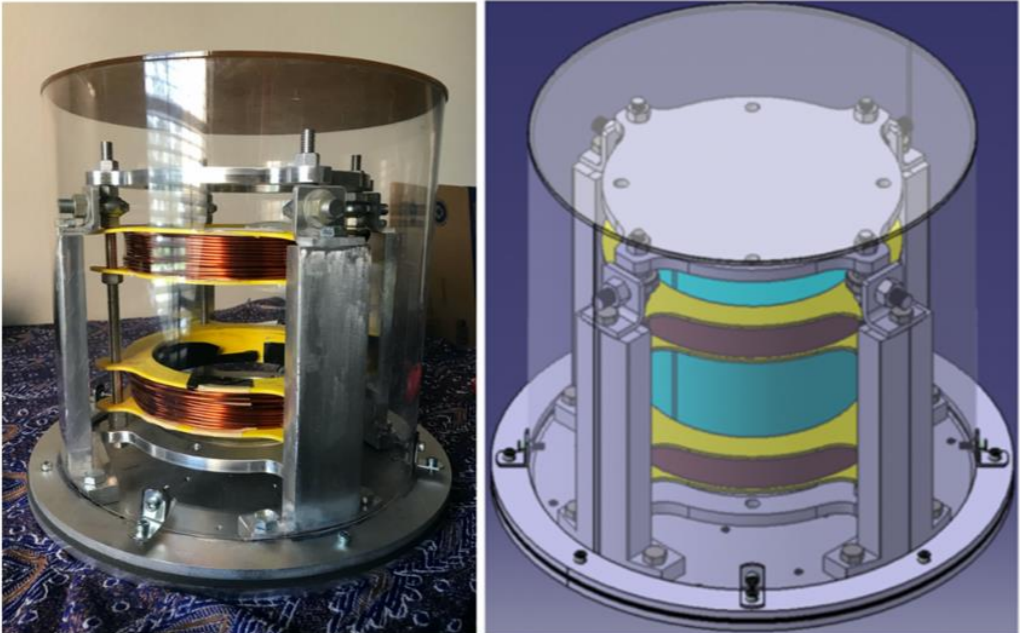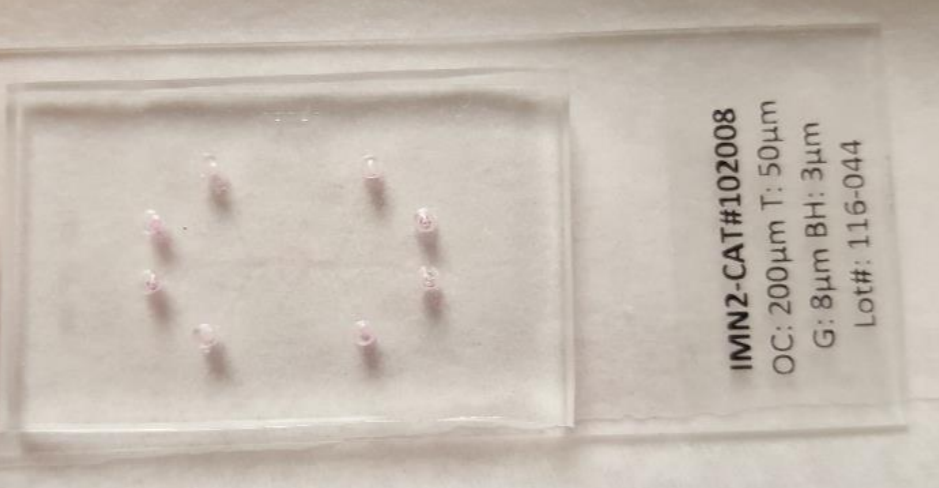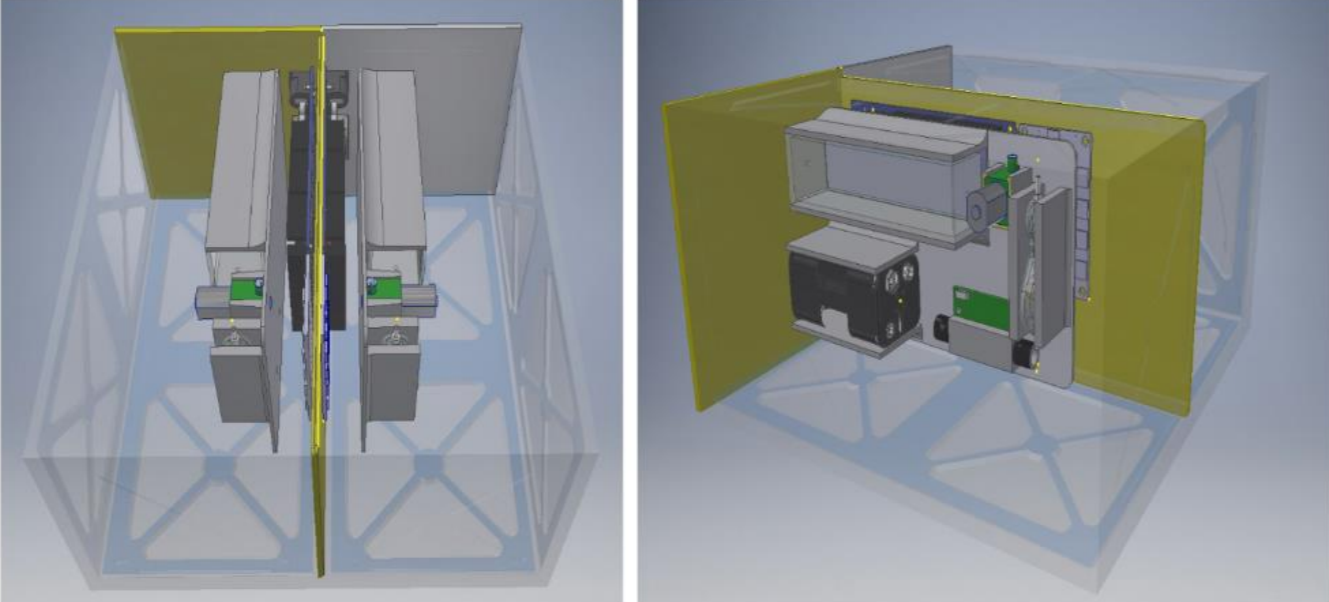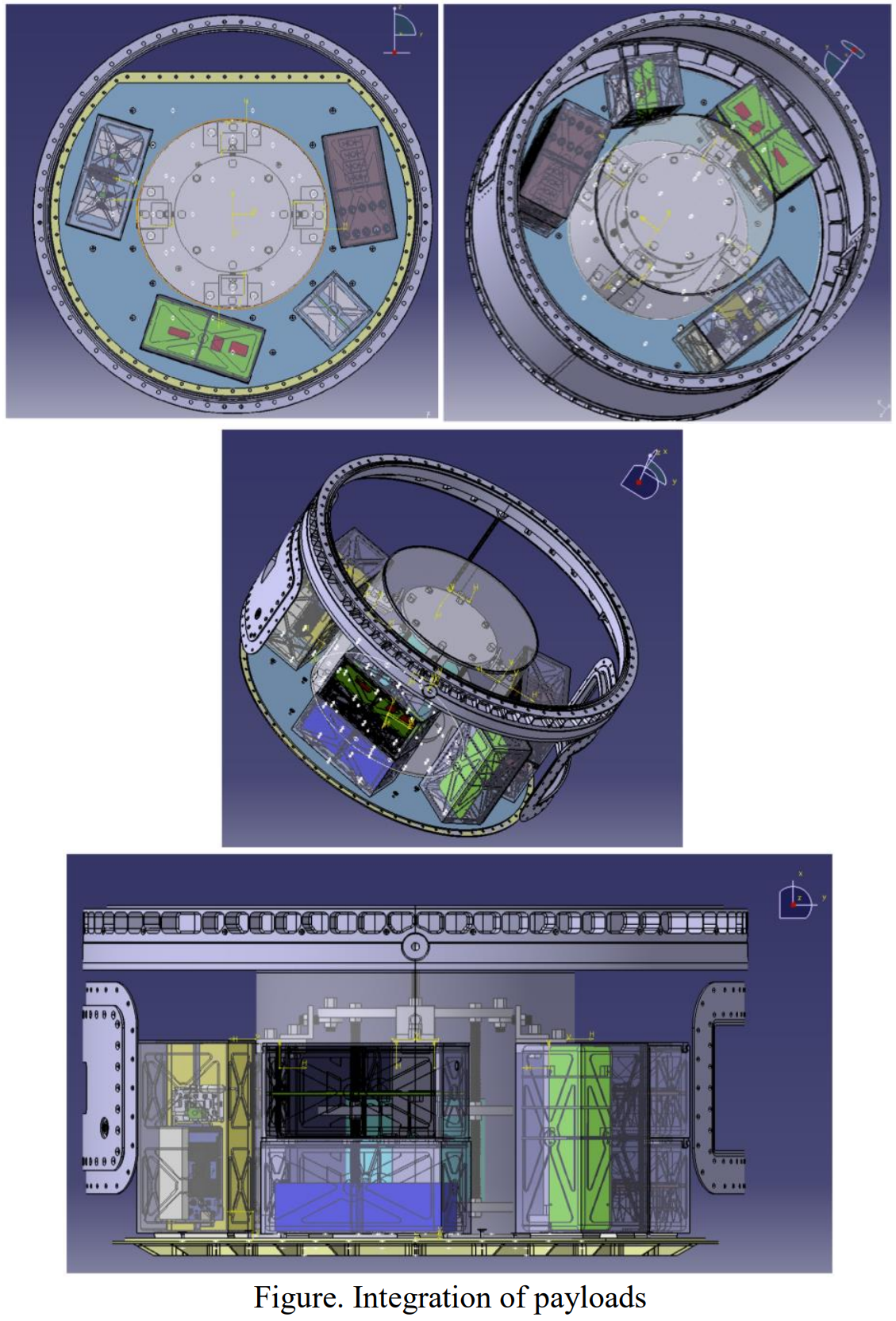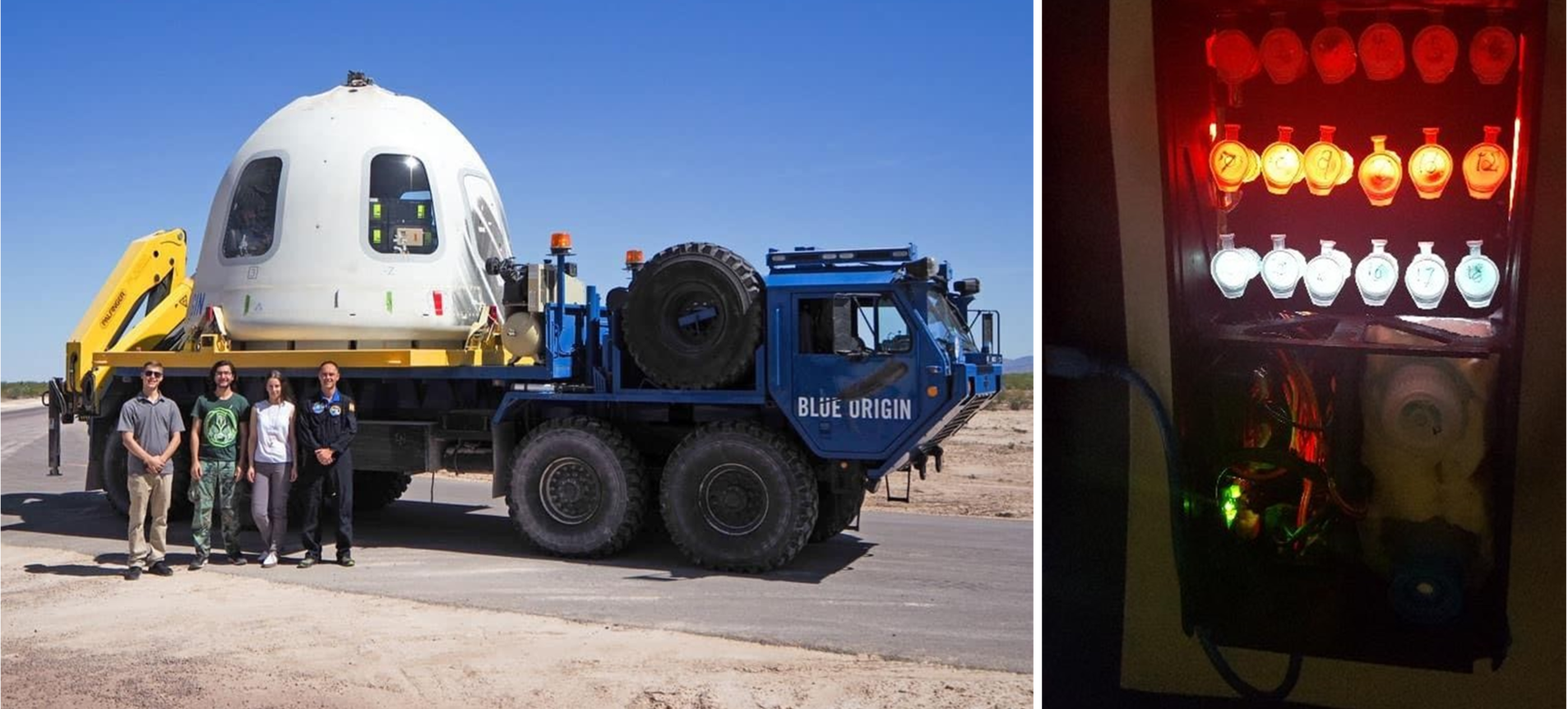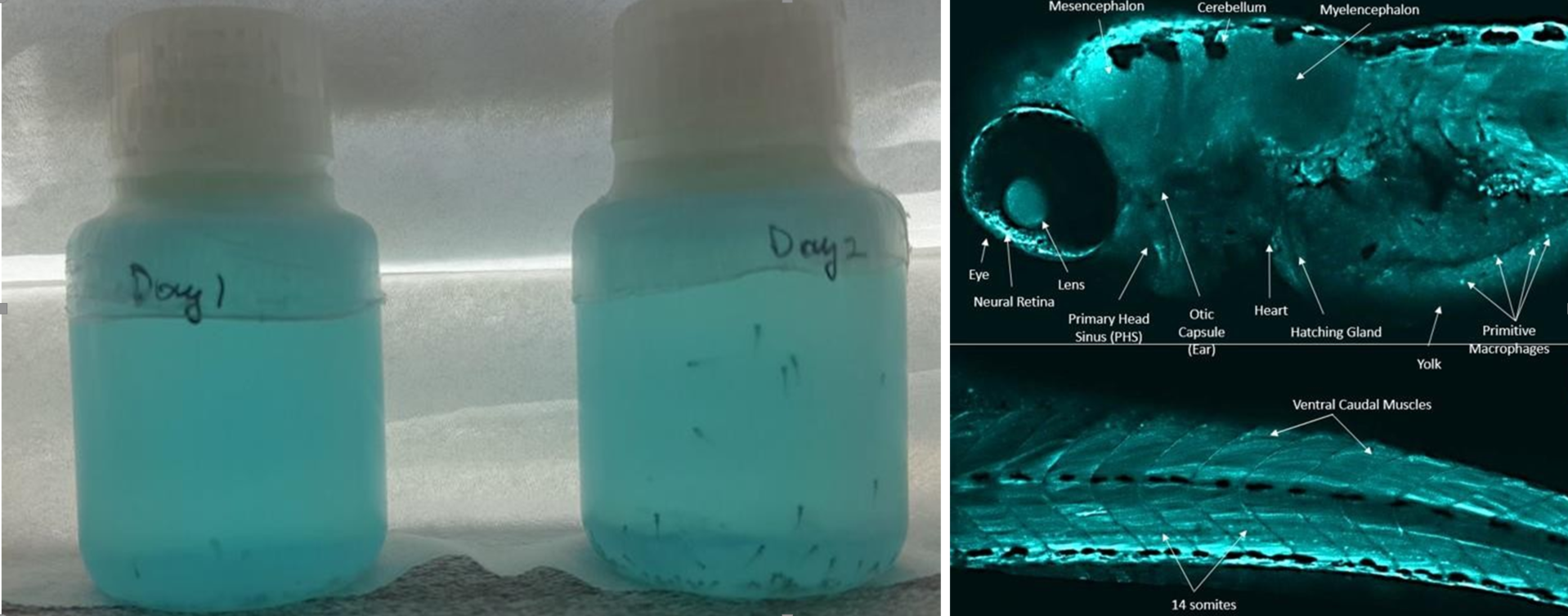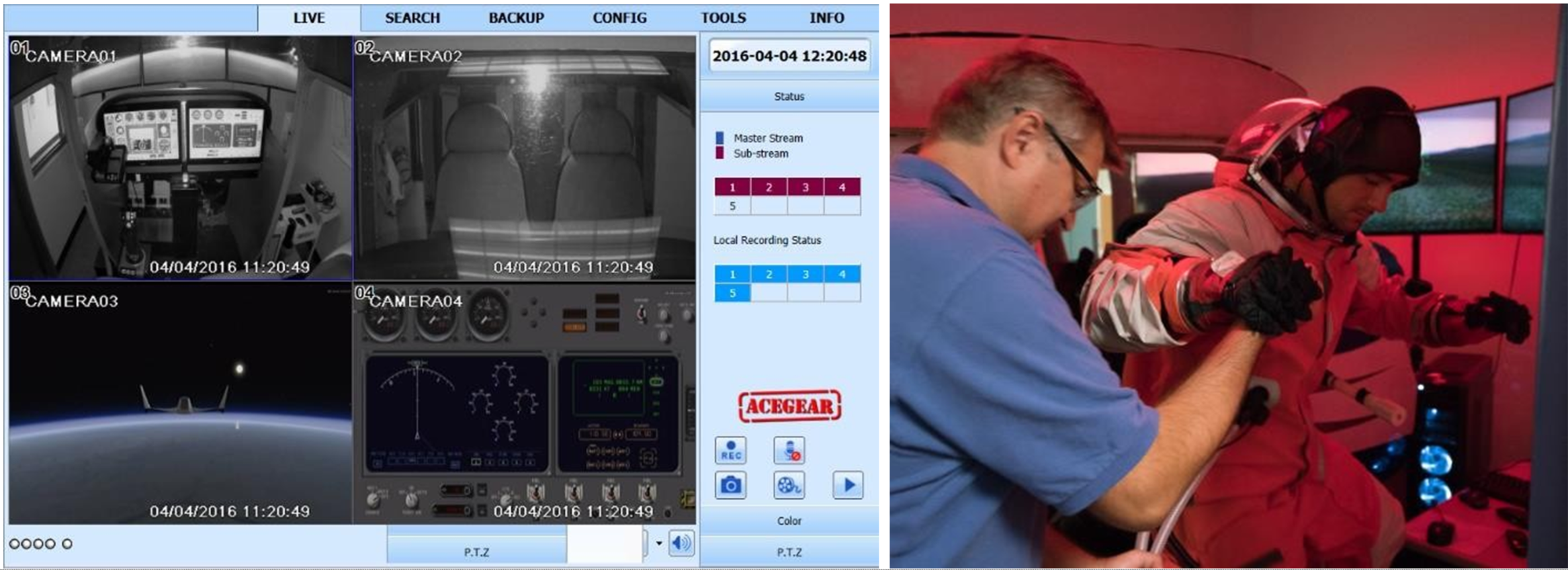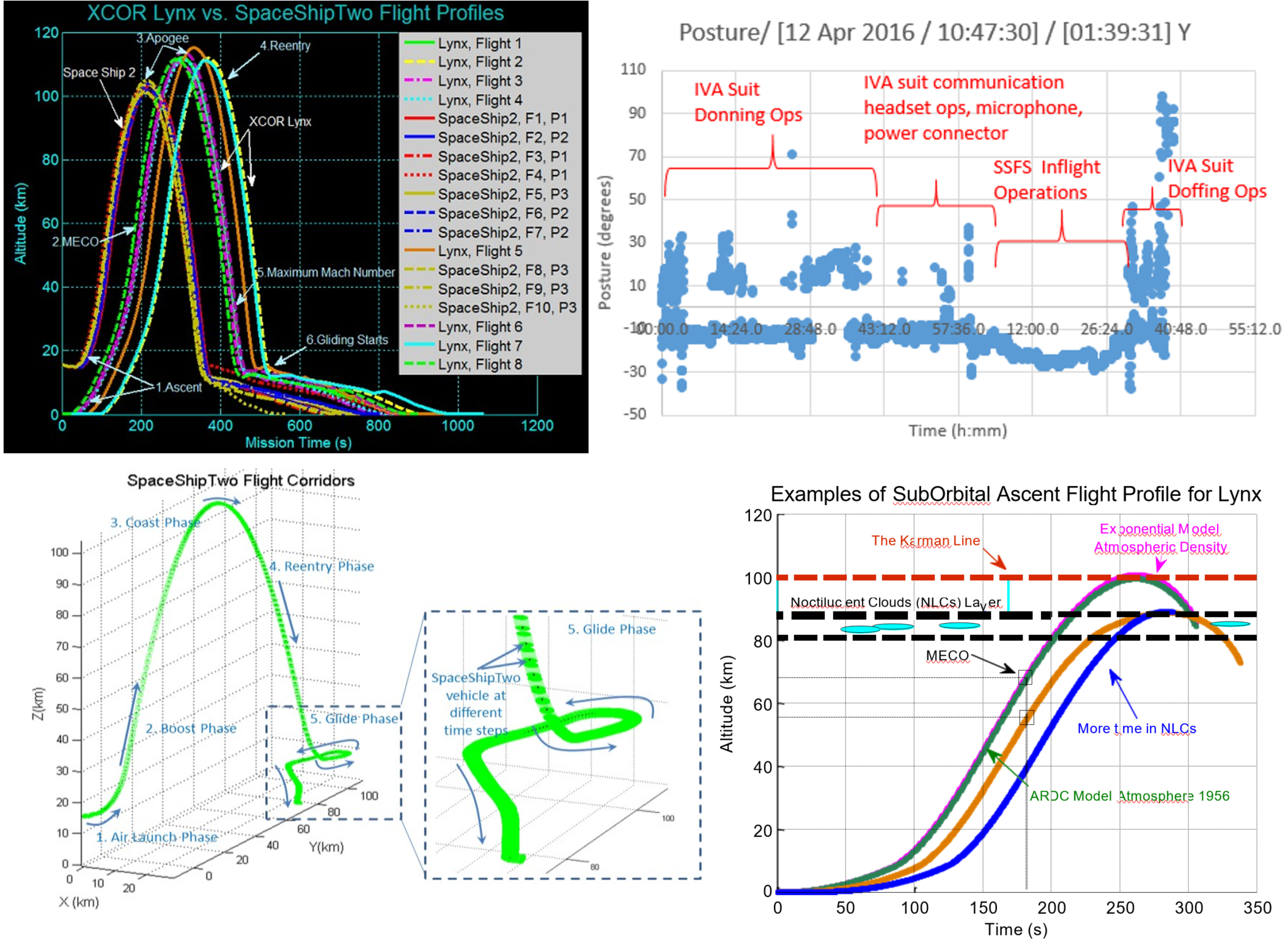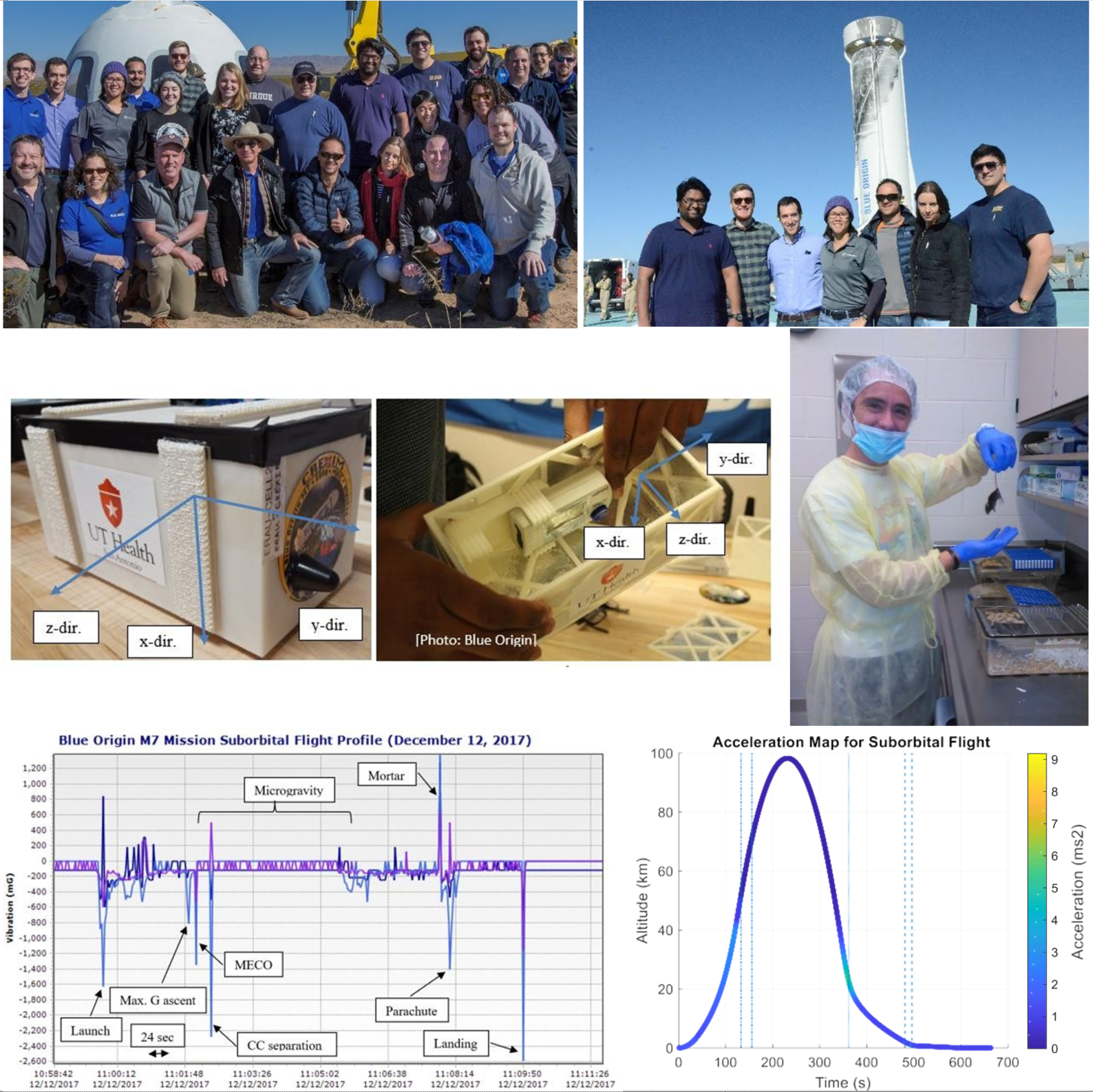111-120 of 238 results
-
Vertical Lift Research Center of Excellence (VLRCOE)
PI John Leishman
CO-I Ebenezer Gnanamanickam
CO-I Kaijus Henri Palm
CO-I Guillermo Mazzilli
Ship airwakes are the unsteady turbulent flows that are generated by the earths atmospheric boundary layer (the wind colloquially) blowing over a ship. These flow fields are highly turbulent, not easy to predict and couple with a similar wake flow field generated by a rotorcraft operating close the the ship. This coupling as expected is extremely difficult to predict let along faithfully simulate in a flight simulator. This coupling can have catastrophic consequences for the operation or rotorcraft operating in the vicinity of Naval ships.
Ship airwakes are the unsteady turbulent flows that are generated by the earths atmospheric boundary layer (the wind colloquially) blowing over a ship. These flow fields are highly turbulent, not easy to predict and couple with a similar wake flow field generated by a rotorcraft operating close the the ship. This coupling as expected is extremely difficult to predict let along faithfully simulate in a flight simulator. This coupling can have catastrophic consequences for the operation or rotorcraft operating in the vicinity of Naval ships.
While ship airwakes have now been studied for several decades, there remain many unanswered questions and associated challenges in understanding these unsteady, three-dimensional flows, particularly concerning their turbulence characteristics and how flow scales in the airwake can potentially couple with those of a rotorcraft, including Unoccupied Aerial Systems (UAS). Navy personnel and aircraft safety remain the primary motivating factor for understanding the airwake and the interactions so produced. In this regard, developing a versatile, high-fidelity mathematical model to represent the ship airwake in a flight simulation, such as using a reduced-order mathematical representation, remains a priority for the technical community. This goal is particularly critical for more contemporary ship shapes typical of the current Navy inventory. It is toward this end that the fluid dynamic studies of the airwake are addressed in this proposed task. Furthermore, a vast majority of ship airwake measurements have not considered the interactions between an operating rotor(craft) and the airwake, another challenge the proposed task will address.
Overall, the mean flow features of the ship airwake are currently reasonably well characterized, at least for simplified ship superstructures such as the SFS2. However, much of the combined spatio-temporal behavior of the ship airwake, in general, has not been measured and so the physics are still poorly understood, particularly for contemporary Navy ship shapes. Organized turbulence structures, their distribution of energy across different scales, and their interactions with, or influence on, or criticality for, a traditional rotorcraft or less conventional UAS are not understood or sufficiently documented so far. The recent time-resolved airwake measurements of the current PIs have better established the true three-dimensional nature of the ship airwake, along with other turbulent aspects of the flow that have not been previously documented. These features include the high degree of intermittency, the bistable nature of the airwake, etc. These recent measurements have highlighted the predominance of low frequencies in the airwake, but not exclusively so. They indicate the likelihood of coupling with the response of any rotor system, large or small These new measurements have emphasized the need for spatially and temporally resolved high-frequency flow measurements that capture the true three-dimensionality of the airwake flow and its turbulent aspects, including intermittency. In addition, parsing these measurements into low-order mathematical models (such as for use in FlightLab or similar) remains a challenge, both in the context of understanding the flow physics and developing a higher-fidelity representation of the airwake for use in piloted simulations. Furthermore, the challenge of measuring, understanding, and representing the interactions between the airwake and a rotor system still remains to be studied at the fidelity needed if faithful models of the airwake are to be realized.
Technical Objectives (ERAU tasks only):
1) With the focus on faithfully capturing the three-dimensionality of the flow and its turbulent aspects (such as the frequency content and intermittency), time-resolved particle image velocimetry (TR-PIV) measurements with high spatio-temporal resolution will be conducted. These measurements are proposed for a more relevant ship geometry, namely the NATO Generic Destroyer (GD) of NATO AVT-315, while also investigating the differences to the widely used SFS2. Also, a representative rotor system will be introduced into the airwake to study the interactions therein. ERAU will use their new subsonic 4x6 ft wind tunnel with a mostly glass test section and the large field of view TR-PIV system awarded under an ONR DURIP. The focus will be on carrying out dual-plane, time-resolved stereo PIV (DPTR-sPIV) measurements, which allow for spatially and temporally synchronous measurements.
2) These datasets will then be used to represent the flow field using reduced-order models (ROMs). The advantages of methods such as wavelets, spectral POD (sPOD), Multi-scale Proper Orthogonal Decomposition (mPOD), and probabilistic/statistics techniques, will be used to acquire physical insights into the complex airwake environment, while describing the flow in a manner that is more relevant to the scales of UAS. This proposed approach will also offer new quantitative metrics for comparing airwakes, sorted into frequencies, which quantitatively reflect the energy distributions, and so they are much more suitable for V&V. ROMs can then be constructed, and flow field physics and interactions can be examined at each scale, whose contours should be comparable across all frequencies.
Categories: Faculty-Staff
-
Effects of Institutional Responses to the COVID-19 Pandemic on Undergraduate Faculty and Students Across STEM Disciplines
PI Chelsea LeNoble
CO-I Allison Kwesell
The project's specific aims are to: (1) examine teaching and learning experiences of undergraduate faculty and students in response to the COVID-19 pandemic; (2) examine the effects of faculty and student reactions on undergraduate STEM teaching and learning; and (3) leverage findings to develop actionable recommendations for colleges and universities to best prepare and protect their faculty, staff, and students and the integrity of undergraduate STEM education.
Categories: Faculty-Staff
-
Eco-Dolphin
PI Hong Liu
CO-I Zakaria Daud
CO-I Ci Wen
CO-I Dynamite Obinna
Eco-Dolphin is the name of a fleet of adaptive and cooperative automated underwater vehicles (AUVs) that a team of students at ERAU have been working on since January 2012.
By 2015, the platforms of the AUVs and basic navigation programs were tested. One of the major success is the demonstration of the Yellow Dolphin where four NASA astronauts participated in the NASA Extreme Environmental Mission Operation (NEEMO) during an event in the summer of 2014. Since 2015, the team started developing and testing the autonomous mission control programs based on the MOOS-IvP middleware developed by MIT and Oxford. Two peer reviewed conference proceedings with student coauthors were published. Students gave two to three presentations each year, including
- FURC, Florida Undergraduate Research Conferences 2012, 2013 and 2014
- SIAM SEA conference in FIT Melbourne, FL 2014
- CASE 2014 Creativity in the Arts and Sciences Event
- A3I Conference at Prescott Campus, 2014
- Discovery Day at Daytona Beach Campus, 2014
- Embry-Riddle Undergraduate Math Conference
- SIAM National Annual Conference
Categories: Undergraduate
-
Collaborative Research: Instabilities and Turbulence in Gravity Wave Dissipation and Formation of Thermospheric Sodium Layers above the Andes
PI Alan Liu
This award will fund continued operations of a sodium (Na) wind-temperature (W&T) lidar at the Andes Lidar Observatory (ALO) in Cerro Pachon, Chile (30.25 S, 70.74 W, elev. 2530 m) supporting scientific studies aimed at the dynamics of mesopause atmospheric instabilities and turbulence structures formation resulting from the gravity wave (GW) dissipation processes for a spatial region above the Andes where the population of mountain GW events is abundant. The Na lidar at ALO is a state-of-the-art resonance-fluorescence Doppler lidar, capable of measuring 3D wind, neutral temperature and Na density profiles with excellent vertical and temporal resolutions within the 80-105 km altitude range (referred to as the MLT region) and with high accuracy. Other possible W&T lidar studies would include the extension of lidar observations into the lower thermosphere, with wind and temperature measurements up to 140 km altitude for the somewhat frequent occurrence of thermospheric sodium layers. The formation of such layers is not understood and will be a significant topic of research in this award. Another interesting application of the ALO observatory is the detection of turbulence scale perturbations in the mesosphere and lower thermosphere temperature and wind profiles that are related to the formation of atmospheric unstable layers and dissipation of GW events.Categories: Faculty-Staff
-
MRI: Acquisition of A Meteor Radar for the Andes Lidar Observatory
PI Alan Liu
This MRI award would acquire a state-of-the-art meteor radar (MR) system that would replace an aging meteor radar located at the Andes Lidar Observatory (ALO), located in Cerro Pachon, Chile (30.26 S, 70.74 W, elev. 2530 m). This clear sky location is ideally situated for making observations of the highly dynamical environment associated with the mountain waves generated by the surface winds blowing over the Andes. This location is also well suited for detecting sodium particles transported to high altitude by the Appleton fountain effect that operates near the geomagnetic equator. Both of these mechanisms make the Andes dynamical environment a "hot spot" that is unique in the world with nothing equivalent available for study in the United States. ALO is an upper atmosphere observatory that supports optical remote sensing instruments, including a wind/temperature (W&T) lidar operating at the sodium wavelength (589 nm) and several airglow instruments. The lidar system measures simultaneously nighttime atmospheric wave perturbations (associated with gravity waves) of temperature, wind and airglow intensities in the mesosphere and lower thermosphere (MLT) region (80-105 km) at high vertical spatial (<1 km) and temporal resolutions (~1 min) during the low moon period of each month. The MR data provides measurements of the background tidal winds that allow the determination of the intrinsic phase speeds needed for studying gravity wave propagation physics. These results taken together are aimed at achieving a detailed study of atmospheric waves and turbulence structures through modeling comparisons of data with turbulent structure morphology. This project will support engineering undergraduate students at ERAU thus helping to extend the STEM undergraduate education effort at ERAU into the remote sensing area. One graduate and one undergraduate student would be directly involved in this project. Moreover, these applications made possible by the enhanced quality of the MR data would provide new opportunities for graduate student training in the radar remote sensing technology as well as having these students undertake studies regarding new questions in upper atmosphere research. Students involved will learn the principles of the MR remote sensing technique through the use of formal lectures and informal hands-on interactions. Activities involving the graduate student are site radar noise survey, the process of radar installation and subsequent hardware maintenance. The student would also be responsible for data retrieval, validation and archival processing. The undergraduate student would help set up the Madrigal server and update the ERAU website concerning the meteor radar status. These activities will provide training to these students on how to become an experimental scientist. The MR would also support undergraduate and graduate education at ERAU as the department offers an undergraduate course in Space Physics, one MS level course Experimental Methods in Space Science, and two PhD level courses Upper Atmosphere Physics and Remote Sensing: Active and Passive. Students will learn advanced techniques involved in MR and use the MR data for various course projects. Students can design their own software for meteor identification, wind and temperature retrieval.
The MR measures horizontal wind continuously (day and night) in the same altitude region as the height range observed by the lidar with ~2 km vertical and 1 hr resolutions. It complements the optical lidar measurements by providing background tidal wind information that is critical for deriving gravity wave (GW) intrinsic parameters and understanding the phenomenology of GW wave propagation with regard to reflection, ducting, and dissipation processes. The MR capability for continuous wind measurement is essential for resolving longer time scale oscillations such as atmospheric tides and planetary waves, and for the study of their interactions with small-scale waves. The new MR will not only continue the MR wind measurement series but also provides new capabilities to infer temperature, turbulence diffusion coefficient, and the diurnal variation of GW momentum flux.Categories: Faculty-Staff
-
Collaborative Research: DASI Track 2--A Distributed Meteor Radar and Optical Network in South America
PI Alan Liu
This project will establish a distributed network of meteor radars and optical instruments in the mid-latitudes of South America, providing continuous measurements of upper atmospheric winds and nighttime wave perturbations in the mesosphere and thermosphere.
This project will establish a distributed network of meteor radars and optical instruments in the mid-latitudes of South America, providing continuous measurements of upper atmospheric winds and nighttime wave perturbations in the mesosphere and thermosphere. This network will be able to make multi-point observations to resolve detailed four-dimensional (spatial and temporal) structures of small-scale (tens to hundreds km) waves. These small-scale waves are known to be a key player in driving variabilities at all spatial and temporal scales in this region and this network will provide a much-needed dataset for investigations of these waves and their impacts. The project will provide opportunities to a postdoctoral researcher and Ph.D. students to gain real world experience in working at remote areas to conduct engineering and research work. The project will also promote strong international collaboration with scientists from the United States, Germany, Chile, and Argentina, and will strengthen the ground-based network of instruments for geospace observations in South America.
This network will be built upon two NSF-funded projects to fully leverage the existing infrastructure and expertise that are already developed through NSF?s investments: a Major Research Instrumentation project that supported the deployment of a multi-static meteor radar (MR) system in northern Chile; and an NSF Distributed Array of Small Instruments project MANGO (Midlatitude Allsky-imaging Network for GeoSpace Observations) that established a network across the continental United States with multiple all-sky imagers and Fabry-Perot Interferometers (FPIs). This project will expand the MR system by adding two additional receiver stations, establish an optical network with airglow imagers and an FPI and a data infrastructure to promptly retrieve and share all data products, based on instruments and software developed in MANGO.
This award reflects NSF's statutory mission and has been deemed worthy of support through evaluation using the Foundation's intellectual merit and broader impacts review criteria.Please report errors in award information by writing to: awardsearch@nsf.gov.
Categories: Faculty-Staff
-
PLD Space Suborbital Microgravity Research
PI Pedro LLanos
This project involves the design, development, integration, testing, validation, and verification of various payloads to be flown aboard PLD Space’s MIURA-1 suborbital rocket.
1. Magnetic Active Propellant Management Device (MAPMD) experiment (student involvement)2. In-vitro experiment comprised of both T-cells and Cancer cells3. Cerebrospinal fluid (CSF) shunt experiment (student involvement)4. Environment characterization of the suborbital vehicle experiment (student involvement)
The first payload is a technology demonstration experiment and will consist of testing and validating a hybrid membrane a viable Magnetic Active Propellant Management Device (MAPMD) proof of concept. This technology is already being tested in a parabolic flight through NASA’s Flight Opportunities Program. This MAPMD is a patented technology developed by ERAU and has demonstrated effective slosh suppression in 1g laboratory setting.
The second experiment's objectives will be to further elucidate the mechanisms altering T‐cell behavior under microgravity (expanding our previous research) and examine the microgravity effect on tumor microenvironment with cancer cells (breast and colon). The third experiment objective is to determine the microgravity effects on intracranial pressure by regulations of a cerebrospinal shunt. This research study is aimed to characterize the effects of fluid shift in a shunt generated by changes in the attitude of the rocket. The fourth experiment will be an avionics box with state‐of‐the‐art sensors to measure the environmental conditions of the rocket and compare these flight parameters with the flight provider.
1. MAPMD will enhance the TRL level achieved with previous payloads launched on NASA’s Zero-G parabolic flights. This research will expand our knowledge of fluid behavior management under various flight stressors while enhancing the aerospace technologies of the suborbital market and future orbital endeavors.
2. The In-vitro experiment will enhance our understanding of the biomechanics of cells using novel state-of-the-art technologies. To our knowledge, this will be the first time that these technologies will fly on a suborbital flight. This research will expand the basic applied research answering fundamental science questions. This project is described in more detail in its own section.
The shunt experiment will improve our knowledge on whether people (with hydrocephalus medical condition) could, one day, fly to space. This research is intended to answer basic applied research questions.
3. The telemetry experiment is another S.T.E.M. payload from which researchers expect to gain valuable data of the flight profile and the conditions inside the rocket that may affect other payloads.
4. The telemetry experiment is another S.T.E.M. payload from which researchers expect to gain valuable data of the flight profile and the conditions inside the rocket that may affect other payloads.
Categories: Faculty-Staff
-
Blue Origin’s Suborbital Research: MESSI/McXIMUS
PI Pedro LLanos
CO-I Sathya Gangadharan
The following studies were conducted with Co-PIs Dr. Sathya Gangadharan (ERAU) and Kristina Andrijauskaite (University of Texas Health Science Center in San Antonio [UTHSCSA]).
MESSI Summary: This project was ERAU's second suborbital payload aboard Blue Origin’s New Shepard launched May 2, 2019. We analyzed the effects of suborbital flight stressors and various light conditions (red, white, no light) on the Arthrospira platensis, commonly known as Spirulina, aboard Blue Origin’s New Shepard launch vehicle. Commercially available cyanobacterium species were cultivated and closely monitored in mother colonies several months before the flight. The aim was to estimate biomass production and growth as a potential dietary alternative for prospective human spaceflight's life support system.
McXIMUS Summary: Zebrafish larvae were exposed to the same physiological stressors they would encounter during suborbital space flight: alterations in light, thermal, and centrifugation conditions, and their behavioral responses were analyzed using the DanioVision (Noldus) behavioral tracking system. Our results showed that zebrafish were most active when kept in a dark environment as measured by swim distance. Also, thermal alterations revealed that zebrafish larvae adapted well to the different temperatures ranging from 25°C to 32°C with the highest levels of locomotor activity observed at 32°C. Finally, the centrifugation tests demonstrated that although zebrafish were exhausted initially, their recovery process was short, lasting for approximately five minutes.
Spirulina Research: The Microgravity Experiment for Spirulina as Superfood In-Vitro (MESSI) was funded by internal funds from ERAU and UTHSCA and ERAU's 2018-2019 Ignite Research Grant. Spirulina samples were flown in a NanoLab with adjacent avionics supporting the light conditions and sensors to monitor the temperature, relative humidity, and accelerations. The various flight parameters measured in the NanoLab were validated with the flight data gathered by Nanoracks. Preliminary results of the genes affected by the temperature and light alterations are presented. Our data indicate that the spirulina samples aboard the rocket had elevated expression of most genes when compared to ground controls, especially genes related to magnesium (mgtE) and nitrate-nitrite (nrtP) transport. Furthermore, we saw the most significant up-regulation (p < 0.01-0.001) of genes from the blue-green spirulina microalgae exposed to the red light. Finally, we used laser-scanning confocal microscopy to provide high-resolution imaging visualizations of the spirulina under different conditions (ground, flight, and light conditions). Results indicate that flight samples exposed to red light had the most profound effect on gene expression and showed an enhanced behavior suggesting that photosynthetic organisms are influenced by light energy. Although it is well-known that spirulina needs light and warmth to optimally grow, our findings indicate that spirulina may be able to survive and grow with no light and at lower temperatures than optimally cultivated conditions, which may reduce hardware and resources dependency for prospective long-duration human spaceflight.
Zebrafish Research: Microgravity characterization eXperiment In Microgravity Universal Spacelab (McXIMUS). It has been proved that the presence of humans in space requires meticulous mission design and a critical understanding of physiological parameters. Space is a hostile environment that has caused numerous health hazards in astronauts, including alterations in the vascularization system and high rates of muscle atrophy. Therefore, understanding the molecular pathways mediating space-induced alterations on human physiology is a necessity in making future missions a success. The goal of this study was to use zebrafish (Danio rerio) embryos as a unique model to study molecular mechanisms of simulated and real microgravity effects on vascularization system and stress response. To simulate microgravity, we exposed zebrafish embryos to a two-dimensional clinorotation device starting 1-day postembryonic fertilization (dpf) and lasting for a maximum of four days. Changes in multiple gene expression were measured by qRT-PCR. Thus, we used the KDRL- BSY zebrafish strain with the blue fluorescently labeled vascular system allowing to image vascularization development using confocal microscopy. Our preliminary results indicate that only a small proportion of genes are affected by clinorotation. Our next goal was to confirm our findings by exposing zebrafish embryos (days 2 and 3 dpf) to microgravity during the suborbital flight aboard Blue Origin’s New Sheppard vehicle in the spring of 2019. Our project entitled Muscular characterization in Microgravity Universal Spacelab (McXIMUS) is a joint research collaboration between the Embry- Riddle Aeronautical University (ERAU) and the University of Texas Health Science Center in San Antonio (UTHSCSA). To ensure a safe environment for zebrafish embryos during the suborbital flight, we designed a NanoLab to guarantee stable thermal conditions inside the payload. Our team has established proper procedures and validation checks to maximize the outcome of this novel scientific experiment. Our data indicate that in contrast to clinorotation, zebrafish embryos exposed to suborbital flight had the up-regulated expression of multiple gene families, with the most profound effect observed in vascular endothelial growth factors and heat shock proteins. To the best of our knowledge, this is the first time when Danio rerio was flown on the suborbital flight mission to assess microgravity-induced alterations on the vascularization system and stress. Here, we present only the preliminary results of our ongoing gene expression analysis, as we are further elucidating the possible mechanisms of action. Findings from this experiment give insights into molecular pathways mediating vascular system and stress response and will assist in mapping out the strategies aimed to minimize the antagonizing effect of space travel in humans.
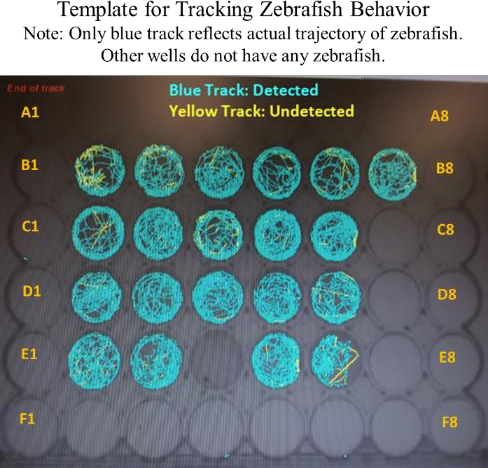
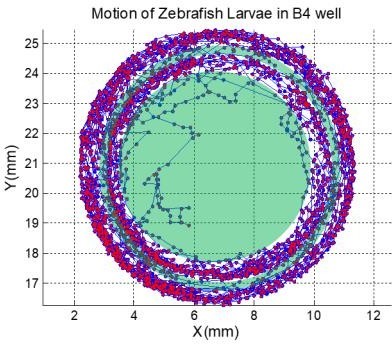
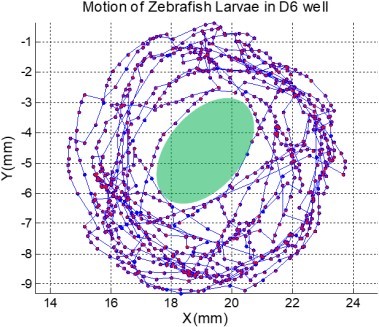
Below: Zebrafish physiology affected by stressors (light, thermal, centrifugation), and the effect of suborbital flight on gene expression.
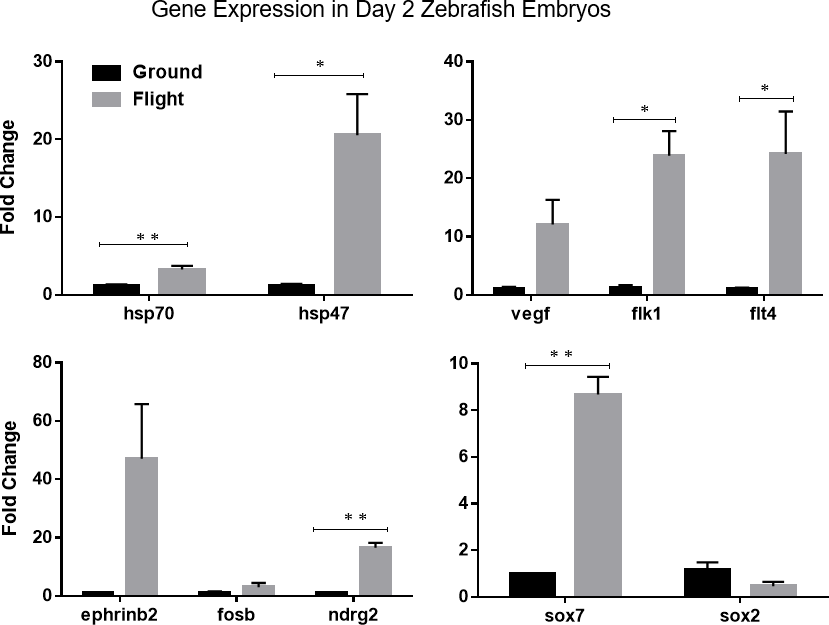
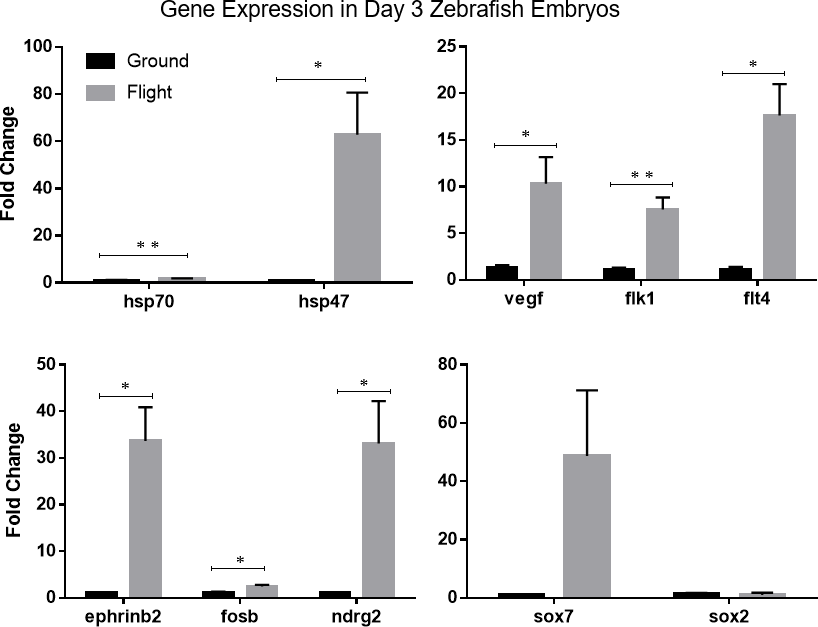
Below left: New Shepard’s Capsule. Below right: NanoLab science experiment with zebrafish embryos and spirulina.
Below left: Flight Zebrafish embryos. Below right: Confocal microscopy of zebrafish.
Below: Confocal microscopy of spirulina flight samples.
Categories: Faculty-Staff
-
Aviation/Aerospace Research: Suborbital Space Flight Simulator
PI Pedro LLanos
CO-I Erik Seedhouse
The Suborbital Space Flight Simulator (SSFS) replicates in-vehicle parameters of a suborbital launch vehicle. These suborbital missions can be monitored from the Mission Control Center (MCC). These flight parameters include the size, general layout, and typical system indicators for a suborbital spaceflight mission, as well as an approximate replication of the visuals that would be seen on a suborbital spaceflight mission. The SSFS can be configured to replicate the mission profile and layout of multiple suborbital launch vehicles. The SSFS records 56 flight data parameters that can be used for studies. The SSFS can potentially be used by multiple organizations, with multiple capabilities.
This research will help students and researchers to use SSFS-generated data to improve their understanding of the fundamentals of suborbital space flight, improve the confidence levels of this research tool for training purposes, and generate large datasets of suborbital missions that can be used for flight operational quality assurance (FOQA). By analyzing these simulated suborbital flights, it will be possible to learn a great deal about the different parameters of various suborbital trajectories and assess pilot performance.
It will also be possible to assess metrics aligned with the flight profile and to determine difficulties the pilot encountered when flying nominal and off-nominal profiles. Some of these difficulties are addressed herein and displayed in a graphical context to assist the reader’s visualization. This research capability enhances our understanding of some key factors, such as winds effects, trajectory, and vehicle parameters variations to streamline the space vehicle operations and enhance science in the upper mesosphere at about 85 km, where different types of science activities can be conducted, such as neutral dynamics, gravity waves, tides, oscillations, and noctilucent clouds imagery and tomography. Understanding these effects is crucial to refine current space operations and establish more robust procedures. These procedures will involve training new space operators to conduct and coordinate space operations in class E above FL600 airspace within the Air Traffic Organization (ATO). Space vehicles such as SpaceShipTwo can spend up to 6 minutes in class E airspace above FL600 after launch. Most of this time is dedicated to science data collection in microgravity and maximizing the science is a key priority. Typical suborbital trajectories cut through the noctilucent cloud layer in the mesosphere region from about 260,000 feet to 280,000 feet during the ascent and descent. This space activity falls within the D-layer of the ionosphere (50-90 km). In each of these segments, the space vehicle spends about 10 seconds in the region of interest, totaling about 20 seconds of total in-situ uninterrupted science in the mesosphere. The SSFS is an important tool to evaluate key functional data parameters that must be considered for suborbital spaceflight participants wearing pressurized suits for intravehicular activity (IVA) from Final Frontier Design’s (FFD) fully pressurized third-generation spacesuit as part of their training. Zephyr BioHarness, BioRadio instrumentation, and Hexoskin smart shirt can be used to collect biometric response data from the participants as they performed their duties inside the SSFS.The SSFS is also equipped with MCC with several consoles, such as Flight (Director), Surgeon, Weather, Integrated communications officer, and Air Traffic Control.
Images below: Mission Control Center and Suborbital Space Flight Simulator
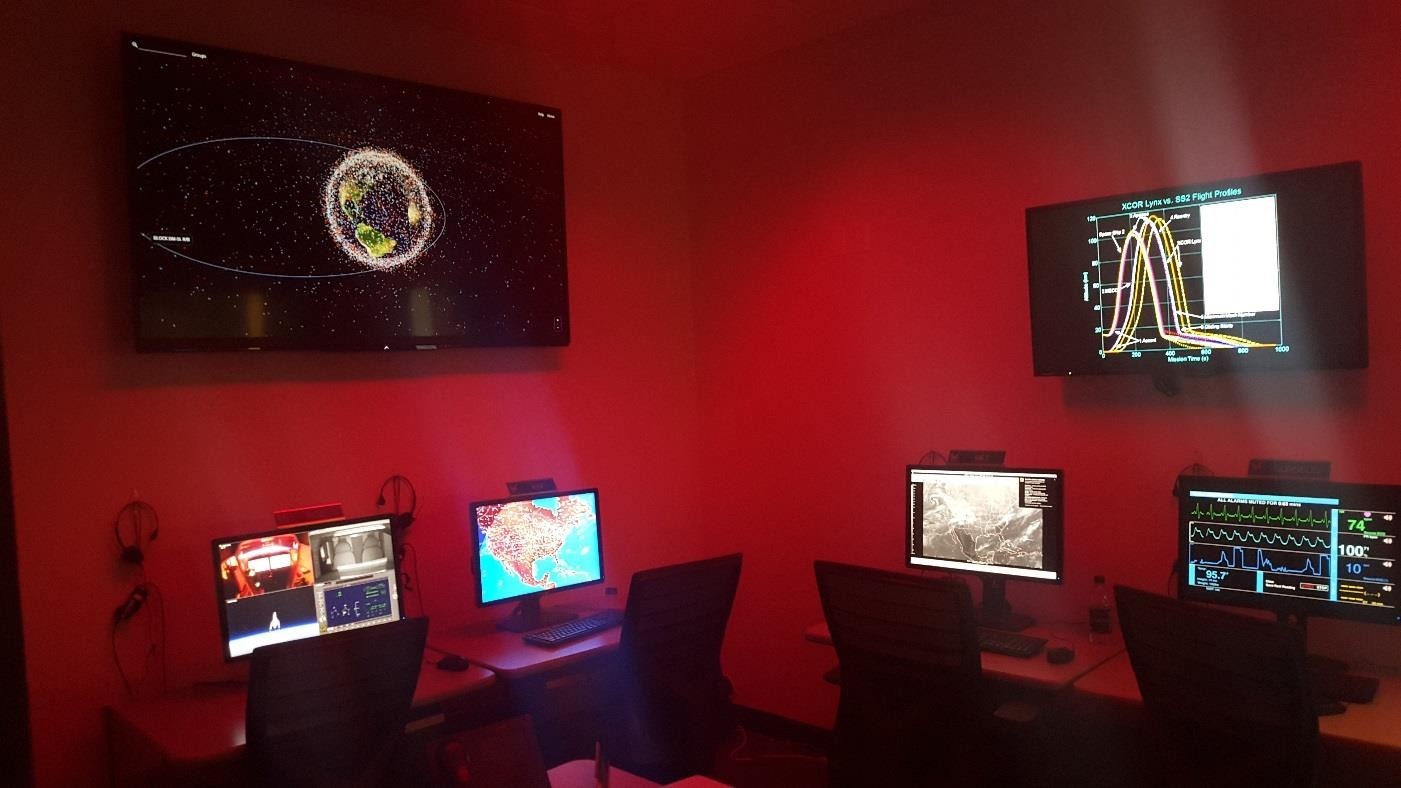
Images below: Examples of suborbital trajectories with several space vehicles. Some of these trajectories can be used to maximize science operations
Categories: Faculty-Staff
-
Blue Origin’s Suborbital Research: CRExIM
PI Pedro LLanos
CO-I Sathya Gangadharan
This research conducted with Co-Investigators Sathya Gangadharan (ERAU) and Kristina Andrijauskaite (MUSC/UTHSCSA), funded by ERAU’s Faculty Research Development Program, was ERAU's first suborbital payload aboard Blue Origin’s New Shepard launched December 12, 2017. The main aim of this research was to investigate the effect of microgravity on T-cells and to understand how this research could be used to develop T-cell-based therapeutics for cancer patients. A second goal was to monitor the environment that T-cells encountered during suborbital flight. The recorded data will be used to better understand the behavior and functionality of the T-cells when exposed to different stressors.
Suborbital space research is emerging as a popular platform to conduct scientific experiments. It has many advantages compared to research on the International Space Station (ISS), such as cost-effectiveness, rapid turnaround, and an opportunity to valid payloads before investing in more costly space laboratory environments. There have been many initiatives by NASA to accelerate this research, such as the release of the Space Biology Plan for 2016-2025, aimed to investigate the biological effects of long-term exposure to the space environment. Therefore, our scientific findings will build upon current research to expand the knowledge on the microgravity effect on T-cells and will also establish a baseline for us to compare future findings from subsequent suborbital flights aboard various research platforms.
This research project was a joint collaboration between the College of Aviation and the College of Engineering at ERAU and The University of Texas Health Science Center at San Antonio (UTHSCSA) and Medical University of South Carolina (MUSC) who worked on the preparation of the translational science research project aimed at investigating the effect of microgravity on the T-cells of a murine model. Cell Research Experiment In Microgravity (CRExIM) was launched aboard Blue Origin’s New Shepard suborbital vehicle on Tuesday, December 12, 2017, from the West Texas Launch Site in Van Horn, Texas. One of the aims of this science experiment was to assess the effects of microgravity on murine T-cells during suborbital flight. These cells were placed in a NanoLab with a data logger which sensed the acceleration, temperature, and relative humidity during pre-flight, flight, and post-flight operations. Some discrepancies in sensor measurement were noticed and these errors were attributed partly to the difference in sampling rates and partly to the different location of the sensors, which made it difficult to obtain highly accurate measurements of the accelerations and to correlate both sets of data. This research provides setbacks and lessons learned which made our team find new alternatives while meeting all milestones as mandated by NanoRacks and Blue Origin. This research highlights these alternatives which lead to the success of the mission and gives recommendations that will enable customers to alleviate some of these challenges in future flights.
Preliminary results suggest that suborbital space flight modulated the expression of certain subpopulations of T-cells, especially CD4+ and CD8+ cells. Thus, we have also observed the functional differences between the flown T-cells and the ground controls. Our scientific experiments and data analyses were conducted at Dr. Wargovich’s laboratory at UTHSCSA using the flow cytometry core facility. In addition, we have performed a complex cytokine expression analysis using the Invitrogen Mouse Custom ProcartaPlex 5-plex.
Below top: Our team with Blue Origin and NanoRacks teams. Below bottom: Our payload and data collected during the suborbital flight.
Categories: Faculty-Staff
111-120 of 238 results

